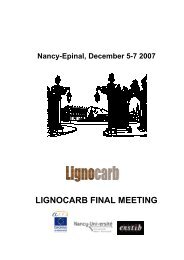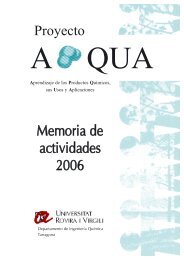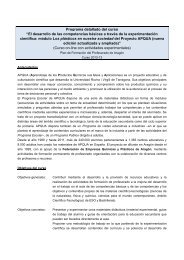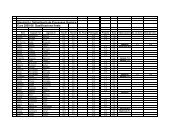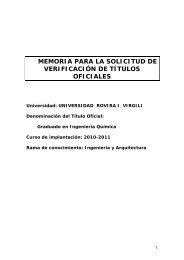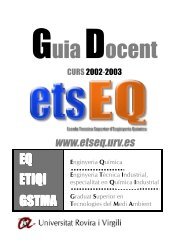A Transferable Force Field To Predict Phase Equilibria and Surface ...
A Transferable Force Field To Predict Phase Equilibria and Surface ...
A Transferable Force Field To Predict Phase Equilibria and Surface ...
Create successful ePaper yourself
Turn your PDF publications into a flip-book with our unique Google optimized e-Paper software.
Received: April 8, 2011<br />
Revised: July 28, 2011<br />
Published: July 29, 2011<br />
ARTICLE<br />
pubs.acs.org/JPCB<br />
A <strong>Transferable</strong> <strong>Force</strong> <strong>Field</strong> <strong>To</strong> <strong>Predict</strong> <strong>Phase</strong> <strong>Equilibria</strong> <strong>and</strong> <strong>Surface</strong><br />
Tension of Ethers <strong>and</strong> Glycol Ethers<br />
Nicolas Ferr<strong>and</strong>o,* ,†,‡ Veronique Lachet, † Javier Perez-Pellitero, †,§ Allan D. Mackie, § Patrice Malfreyt, ^<br />
<strong>and</strong> Anne Boutin ||<br />
†<br />
IFP Energies Nouvelles, 1-4 avenue de Bois-Preau, 92852 Rueil-Malmaison, France<br />
‡<br />
Laboratoire de Chimie-Physique, CNRS, Universite Paris-Sud, b^at. 349, 91405 Orsay Cedex, France<br />
§<br />
Departament d'Enginyeria Química, ETSEQ, Universitat Rovira i Virgili, Avinguda dels Pa€isos Catalans, 26 Campus Sescelades,<br />
43007 Tarragona, Spain<br />
^<br />
Clermont Universite, Universite Blaise Pascal, Laboratoire de Thermodynamique et Interactions Moleculaires, UMR CNRS 6272,<br />
BP 10448, F-63000, Clermont-Ferr<strong>and</strong>, France<br />
Ecole Normale Superieure, Departement de Chimie, UMR 8640, CNRS-ENS-UPMC, 24, rue Lhomond, 75005 Paris, France<br />
bS Supporting Information<br />
)<br />
ABSTRACT: We propose a new transferable force field to simulate phase<br />
equilibrium <strong>and</strong> interfacial properties of systems involving ethers <strong>and</strong> glycol ethers.<br />
On the basis of the anisotropic united-atom force field, only one new group is<br />
introduced: the ether oxygen atom. The optimized Lennard Jones (LJ) parameters<br />
of this atom are identical whatever the molecule simulated (linear ether,<br />
branched ether, cyclic ether, aromatic ether, diether, or glycol ether). Accurate<br />
predictions are achieved for pure compound saturated properties, critical properties,<br />
<strong>and</strong> surface tensions of the liquid vapor interface, as well as for pressure<br />
composition binary mixture diagrams. Multifunctional molecules (1,2-dimethoxyethane,<br />
2-methoxyethanol, diethylene glycol) have also been studied using a<br />
recently proposed methodology for the calculation of the intramolecular electrostatic<br />
energy avoiding the use of additional empirical parameters. This new force field appears transferable for a wide variety of<br />
molecules <strong>and</strong> properties. It is furthermore worth noticing that binary mixtures have been simulated without introducing empirical<br />
binary parameters, highlighting also the transferability to mixtures. Hence, this new force field gives future opportunities to simulate<br />
complex systems of industrial interest involving molecules with ether functions.<br />
1. INTRODUCTION<br />
Because of their various applications as solvents in biochemistry<br />
<strong>and</strong> organic chemistry, there is considerable interest in the<br />
thermophysical properties of ethers. Aliphatic <strong>and</strong> cyclic ethers<br />
are used as solvents or cosolvents in chromatographic stationary<br />
phases, organic synthesis, <strong>and</strong> supercritical fluids. Ethers are also<br />
involved in a large variety of industrial processes in the oil <strong>and</strong> gas<br />
industry. Cyclic ethers such as tetrahydrofuran (THF) are<br />
particularly suitable for hydrate-based gas separations since they<br />
can be added to promote clathrate hydrate formation. 1 Multifunctional<br />
ethers such as glycol ethers are involved in gas<br />
sweetening <strong>and</strong> dehydration processes. 2,3 The production of<br />
biofuels by incorporating aliphatic ethers to classical fuels, such<br />
as dimethyl ether in liquefied petroleum 4 or diethyl ether in<br />
diesel, 5 is also of primary interest nowadays. All of these<br />
applications require a good knowledge of phase equilibrium<br />
<strong>and</strong> phase properties of both pure fluids <strong>and</strong> mixtures involving<br />
this class of oxygenated compounds. Reliable <strong>and</strong> predictive<br />
models are thus needed in this context.<br />
In the last few years, transferable united-atom force fields have<br />
been developed to make molecular simulation an efficient tool to<br />
predict equilibrium properties of pure fluids <strong>and</strong> mixtures with an<br />
acceptable precision <strong>and</strong> a reduced computational time. 6 However,<br />
transferable united-atom force fields for ethers are relatively<br />
scarce in literature. The OPLS-UA force field (Optimized<br />
Potential for Liquid Simulations) developed by Briggs et al. for<br />
dimethyl, ethyl methyl, <strong>and</strong> diethyl ether was proposed to<br />
reproduce thermodynamic quantities near room temperature<br />
<strong>and</strong> pressure. 7 Far away from these conditions, this model<br />
becomes less accurate, <strong>and</strong> the transferability to other ethers is<br />
questionable. <strong>To</strong> account for a better <strong>and</strong> more general description,<br />
Stubbs et al. proposed an extension of the TraPPE-UA force<br />
field (TRAnsferable Potentials for <strong>Phase</strong> <strong>Equilibria</strong>) based on the<br />
development of parameters for the ether oxygen atom combined<br />
with previously optimized parameters for the rest of the<br />
molecule. 8 The simulation of glycol ether molecules is however<br />
restrained to the use of a specific intramolecular repulsion potential<br />
making this approach less transferable for multifunctional molecules.<br />
r 2011 American Chemical Society 10654 dx.doi.org/10.1021/jp203278t | J. Phys. Chem. B 2011, 115, 10654–10664
The Journal of Physical Chemistry B ARTICLE<br />
Table 1. Non-bonded Parameters for the AUA4 <strong>Force</strong> <strong>Field</strong><br />
In this work, we propose to extend the transferable AUA4 potential 9<br />
to ethers by introducing a single new atom corresponding to the<br />
ether oxygen. For the shake of transferability, all of the other<br />
groups are taken from previous parametrizations of the AUA4<br />
force field (see ref 6 for a review), <strong>and</strong> the new Lennard Jones<br />
(LJ) parameters of the oxygen force center proposed in this<br />
work are the same whatever the ether simulated. <strong>To</strong> highlight<br />
the transferability of the developed force field, various families<br />
of ethers are studied (linear, branched, cyclic, aromatic,<br />
diethers, <strong>and</strong> glycol ethers). At the same time, binary mixtures<br />
with hydrocarbons <strong>and</strong> alcohols are considered. In addition to<br />
the prediction of classical saturated phase properties, we also<br />
calculate the liquid vapor surface tension of dimethyl ether<br />
using the new force field.<br />
This paper is organized as follows: the proposed force field is<br />
described in Section 2. The simulation methods used to calculate<br />
phase equilibrium <strong>and</strong> interfacial properties of pure compounds<br />
<strong>and</strong> binary mixtures are detailed in Section 3. Section 4 presents<br />
the results obtained for saturated properties, liquid phase structure,<br />
<strong>and</strong> surface tension predictions of a wide variety of pure<br />
ethers as well as phase diagrams of mixtures. Finally, Section 5<br />
gives our conclusions.<br />
2. FORCE FIELD DEVELOPMENT<br />
2.1. Intermolecular Energy. 2.1.1. Dispersive-Repulsive Energy.<br />
The dispersive-repulsive intermolecular interactions between two<br />
force centers i <strong>and</strong> j are described through a 12-6 LJ potential:<br />
U LJ<br />
ij ¼ 4εij<br />
atom ε (K) σ (Å) δ (Å) q (e)<br />
CH3 ( CHx) 120.15 3.607 0.216 0<br />
CH3 ( Oether) 120.15 3.607 0.216 +0.223<br />
(dimethyl ether <strong>and</strong> multifunctional ethers); +0.185<br />
(linear <strong>and</strong> branched monoethers)<br />
(CHx )CH2linear ( CHx) 86.29 3.461 0.384 0<br />
(CHx )CH2linear ( Oether) 86.29 3.461 0.384 +0.223<br />
(dimethyl ether <strong>and</strong> multifunctional ethers); +0.185<br />
(linear <strong>and</strong> branched monoethers)<br />
(CH x )CH 2linear ( O alcohol) 86.29 3.461 0.384 +0.265<br />
(CH2cyc )CH2cyc( CH2cyc) 90.09 3.461 0.336 0<br />
(CH2cyc )CH2cyc( Oether) 90.09 3.461 0.336 +0.295<br />
(CHx )CH aliph( Oether) 50.98 3.363 0.646 +0.185<br />
(CHx )C aliph( Oether) 15.04 2.44 0 +0.185<br />
CHarom 89.40 3.246 0.407 0<br />
Carom( Oether) 37.70 3.246 0 +0.223<br />
Oalcohol 125.01 3.081 0.01 0.700<br />
Halcohol 0 0 0 +0.435<br />
Oether 59.69 2.991 0 0.446<br />
(dimethyl ether, aromatic ethers, <strong>and</strong> multifunctional ethers); 0.370<br />
(linear <strong>and</strong> branched monoethers); 0.590 (cyclic ethers)<br />
2<br />
4<br />
σij<br />
rij<br />
! 12<br />
σij<br />
rij<br />
! 6<br />
3<br />
5 ð1Þ<br />
where rij, εij,<strong>and</strong>σij are the distance, the LJ well depth, <strong>and</strong> the LJ<br />
size, respectively.<br />
Cross LJ parameters are obtained using Lorentz<br />
combining rules:<br />
Berthelot<br />
εij ¼ ffiffiffiffiffiffiffiffi p<br />
εiiεjj<br />
ð2Þ<br />
σij ¼ 1<br />
2 ðσii þ σjjÞ ð3Þ<br />
All of the LJ parameters involved in the hydrocarbonated <strong>and</strong><br />
hydroxyl parts of the molecules studied in this work are taken<br />
without any modification from the AUA4 potential for<br />
hydrocarbons 9 12 <strong>and</strong> alcohols. 13 The totality of the parameters<br />
are summarized in Table 1. In the AUA model, the LJ center is<br />
not located on the atomic nuclei of the group but slightly shifted<br />
by a distance δ (AUA displacement) to implicitly take into<br />
account the presence of its bonded hydrogen atoms. In this work,<br />
a single new force center is introduced for the ether oxygen atom.<br />
Since no AUA displacement is required in the case of this center<br />
of force, the only parameters to be adjusted are the LJ parameters<br />
σ0 <strong>and</strong> ε0.<br />
The optimization procedure applied for the LJ parameters<br />
used in this work has been described elsewhere. 14 It consists in<br />
minimizing the mean square relative deviation F between<br />
experimental <strong>and</strong> calculated properties Xi:<br />
F ¼ 1<br />
n ∑n<br />
ðX<br />
i ¼ 1<br />
calc<br />
i<br />
X exp<br />
i Þ 2<br />
si 2<br />
10655 dx.doi.org/10.1021/jp203278t |J. Phys. Chem. B 2011, 115, 10654–10664<br />
ð4Þ<br />
where n denotes the total number of target values <strong>and</strong> s the sum<br />
of statistical <strong>and</strong> experimental uncertainties for a given property.<br />
The properties used in this adjustment procedure are the<br />
saturated liquid density, vapor pressure, <strong>and</strong> vaporization enthalpy<br />
of ethyl methyl ether at temperatures of 280 <strong>and</strong> 420 K.<br />
The experimental associated uncertainties are 1.5%, 5%, <strong>and</strong> 2%,<br />
respectively. This compound has been selected due to the fact<br />
that it includes both CH2 <strong>and</strong> CH3 neighboring ether group<br />
effects. The final optimized LJ parameters are given in Table 1.
The Journal of Physical Chemistry B ARTICLE<br />
Figure 1. Schematic representation of the ether function in the<br />
proposed molecular model. q1, q2, <strong>and</strong> q3 st<strong>and</strong> for the partial electrostatic<br />
charges located on the carbon <strong>and</strong> oxygen atoms.<br />
Figure 2. Experimental 15 gas phase dipole moments of ethers (diamonds:<br />
linear ethers, squares: branched ethers, circles: aromatic ethers, triangles:<br />
cyclic ethers).<br />
2.1.2. Electrostatic Energy. The electrostatic interaction between<br />
two partial electrostatic charges i <strong>and</strong> j is modeled by the<br />
Coulomb potential:<br />
U elec<br />
ij<br />
¼ qiqj<br />
4πε0rij<br />
ð5Þ<br />
where rij is the distance between charges i <strong>and</strong> j, qi the magnitude<br />
of charge i, <strong>and</strong> ε0 the vacuum permittivity.<br />
We adopt a three partial charge distribution involving one<br />
negative charge located on the oxygen atom <strong>and</strong> two symmetric<br />
positive charges on the bonded carbonated groups (see illustration<br />
in Figure 1). Concerning the magnitude of these charges, the<br />
use of a unique set of charges for the totality of the studied ether<br />
molecules is questionable. The transferability of electrostatic<br />
charges is justified as long as all studied molecules have a similar<br />
dipole moment. Figure 2 shows the evolution of the experimental<br />
gas phase dipole moment of various linear, branched, cyclic <strong>and</strong><br />
aromatic ethers in function of the number of carbon atoms. 15 In<br />
light of this graph, we propose to split the molecules in three<br />
groups. The first group (denoted further as group 1) contains<br />
branched <strong>and</strong> linear ethers (except dimethyl ether). The second<br />
group (group 2) contains dimethyl ether <strong>and</strong> aromatic ethers,<br />
<strong>and</strong> finally the third group (group 3) is constituted by cyclic<br />
ethers. Consequently, three different sets of partial electrostatic<br />
charges are proposed. It is well-known that the dipole moment of<br />
a polarizable molecule significantly differs between the gas phase<br />
<strong>and</strong> the liquid phase, <strong>and</strong> it is widely admitted that molecular<br />
models yield better results for phase equilibrium prediction when<br />
using the liquid phase dipole moment. 16 Hence, to determine the<br />
magnitude of the three sets of charges, we adopt a procedure<br />
similar to that described by Eckl et al.: 17,18 an ab initio calculation<br />
is performed by placing a molecule in a dielectric medium whose<br />
Table 2. Bonded Parameters for the AUA4 <strong>Force</strong> <strong>Field</strong><br />
bond length r0 (Å)<br />
CHx—CHy CHx—Oether/alcohol 1.535<br />
1.43<br />
1.36<br />
Carom—Oether CaromdCarom<br />
1.40<br />
Oalcohol—H 0.945<br />
bend θ0 (deg) kbend (K)<br />
CHx—CH2—CHy 114.0 74900<br />
CHx—CH2—Oether/alcohol 109.47 59800<br />
CHx—CH —Oether 112.0 57500<br />
CHx—C—Oether 112.0 57500<br />
CH x—O ether—CH y 112.0 69000<br />
CHaromdCHaromdCHarom 120.0 rigid<br />
CHaromdCarom—Oether/alcohol 120.0 rigid<br />
Carom—Oether—CHx 112.0 69000<br />
CHx—Oalcohol—H 108.5 61000<br />
torsion ai (K)<br />
CHx—CH2—CH2—CHy a0 = 1001.35 a1 = 2129.52<br />
a2 = 303.06 a3 = 3612.27<br />
a4 = 2226.71 a5 = 1965.93<br />
a6 = 4489.34 a7 = 1736.22<br />
a8 = 2817.37<br />
CHx—CH2—CH2—Oether a0 = 839.87 a1 = 2133.17<br />
a2 = 106.68 a3 = 3079.72<br />
CHx—CH2—CH2—Oalcohol a0 = 839.87 a1 = 2133.17<br />
a2 = 106.68 a3 = 3079.72<br />
CHx—CH2—Oether—CHy a0 = 956.05 a1 = 949.25<br />
a2 = 327.50 a3 = 2232.80<br />
CHx—CH2—Oether—Carom a0 = 956.05 a1 = 949.25<br />
a2 = 327.50 a3 = 2232.80<br />
CH3—CH—Oether—CHy a0 = 373.05 a1 = 919.04<br />
a2 = 268.15 a3 = 1737.21<br />
CH3—C—Oether—CHy a0 = 230.65 a1 = 691.92<br />
CHaromdCHaromdCHaromdCHarom rigid<br />
CHaromdCHaromdCarom—Oether/alcohol rigid<br />
a 2 =0 a 3 = 922.58<br />
rigid<br />
OalcoholdCaromdCarom—Oether<br />
CaromdCarom—Oalcohol—H a0 = 845.65 a1 =0<br />
a2 = 845.65 a3 =0<br />
CHaromdCarom—Oether—CHx a0 = 1631.27 a1 = 2651.77<br />
a2 = 868.86 a3 = 2184.14<br />
a4 = 3028.37 a5 = 3065.12<br />
a6 = 1926.79 a7 = 1723.03<br />
a8 = 497.96<br />
Oether—CH2—CH2—Oether a0 = 586.06 a1 = 2775.61<br />
a2 = 2496.45 a3 = 2542.12<br />
a 4 = 3132.43 a 5 = 2249.38<br />
a6 = 4188.47 a7 = 1318.58<br />
a 8 = 2316.03<br />
CH2—CH2—Oalcohol—H a0 = 339.41 a1 = 353.97<br />
a2 = 58.34 a3 = 751.72<br />
Oether—CH2—CH2—Oalcohol a0 = 1530.22 a1 = 4064.26<br />
a2 = 422.78 a3 = 5570.19<br />
10656 dx.doi.org/10.1021/jp203278t |J. Phys. Chem. B 2011, 115, 10654–10664
The Journal of Physical Chemistry B ARTICLE<br />
Table 2. Continued<br />
torsion a i (K)<br />
a4 = 772.20 a5 = 1110.27<br />
a6 = 174.93 a7 = 430.66<br />
a8 = 534.83<br />
dielectric constant is equal to that of the neat liquid of the given<br />
molecule, <strong>and</strong> the magnitude of the partial charges are adjusted to<br />
reproduce the obtained dipole moment. Preliminary ab initio<br />
calculations using the Jaguar software (v.7.0, Schr€odinger LLC,<br />
2007) have shown that the B3LYP/6-311G** level of theory<br />
gives an accurate prediction of experimental gas phase dipole<br />
moments (see Figure S1 in the Supporting Information). Hence,<br />
this level of theory is used for the calculation in the dielectric<br />
medium. Three calculations are performed: the first one with a<br />
molecule of diethyl ether (dielectric constant of 4.27) for the<br />
determination of group 1 charges, the second one with a<br />
molecule of dimethyl ether (dielectric constant of 6.18) for<br />
group 2 charges, <strong>and</strong> the third one with a molecule of THF<br />
(tetrahydrofuran, dielectric constant of 7.52) for group 3 charges.<br />
The resulting liquid phase dipole moments are 1.43 D, 1.69 D,<br />
<strong>and</strong> 2.32 D, respectively, which corresponds to increases from 25<br />
to 40% compared to their respective experimental gas phase<br />
dipole moments. The resulting electrostatic charges are reported<br />
in Table 1.<br />
<strong>To</strong> simulate oxygenated multifunctional molecules involving<br />
an ether function (1,2-dimethoxyethane, 2-methoxyethanol,<br />
diethylene glycol), we take advantage of the transferability of<br />
the force field <strong>and</strong> directly use the LJ parameters <strong>and</strong> partial<br />
charges of monoethers without any readjustment. The choice of<br />
the set of electrostatic charges to be used (group 1 or group 2) is<br />
not evident in some cases. <strong>To</strong> determine which set of charges is<br />
the most appropriate, ab initio calculations in a dielectric medium<br />
have been carried out to determine the liquid phase dipole<br />
moment of 1,2-dimethoxyethane (dielectric constant of 7.3),<br />
2-methoxyethanol (dielectric constant of 16.98), <strong>and</strong> diethylene<br />
glycol (dielectric constant of 31.82) in their most stable conformations.<br />
Then, the dipole moments are calculated using both<br />
sets of charges <strong>and</strong> compared to the ab initio value. Results are<br />
detailed in Supporting Information (Table S1) <strong>and</strong> show that the<br />
group 2 set of charges yields a better restitution of the ab initio<br />
liquid phase dipole moment. This set of charges will be thus<br />
systematically used to model multifunctional molecules.<br />
2.2. Intramolecular Energy. All of the bonded parameters<br />
involved in the intramolecular energy calculation are given in<br />
Table 2. In the proposed force field, all bond lengths are kept<br />
fixed. The CHx Oether bond length is chosen equal to the<br />
CH x O alcohol bond length used in the parametrization of the<br />
force field for alcohols. 13 The Carom Oether bond length encountered<br />
in anisole is taken from Lide. 19 The rest of bond<br />
lengths are taken from the AUA4 force field. 6 Atoms separated by<br />
two bonds interact via a harmonic bending potential:<br />
Ubend<br />
¼<br />
kB<br />
1<br />
2 kbendðcos θ cos θ0Þ 2<br />
ð6Þ<br />
where kB is the Boltzmann constant, kbend the bending constant,<br />
<strong>and</strong> θ <strong>and</strong> θ0 the bending angle <strong>and</strong> the equilibrium bending<br />
angle, respectively. The bending parameters involving the ether<br />
oxygen atom are taken from the AMBER force field, 20 whereas all<br />
other bending parameters are taken from the AUA4 force field.<br />
Figure 3. <strong>To</strong>rsion energy as a function of the dihedral angle. The<br />
convention used is that a dihedral angle equal to 0 corresponds to a trans<br />
conformation. Symbols denote data derived from ab initio calculations,<br />
while solid lines are the corresponding fittings to eq 7. (a) CHaromd<br />
Carom—Oether—CH3 in anisole (ab initio data correspond to the sum of<br />
the two torsions of this type encountered in anisole assuming a shift of<br />
180° between the two dihedral angles; the dashed line corresponds to<br />
the fit of the sum of the two torsions). (b) Oether—CH2—CH2—Oether<br />
in 1,2-dimethoxyethane.<br />
For atoms separated by three bonds, a torsion potential of the<br />
following form is used:<br />
Utors<br />
¼ ∑ kB<br />
8<br />
n ¼ 0<br />
anðcos jÞ n<br />
10657 dx.doi.org/10.1021/jp203278t |J. Phys. Chem. B 2011, 115, 10654–10664<br />
ð7Þ<br />
where j is the dihedral angle <strong>and</strong> ai the ith torsion parameter. If<br />
available, the torsion parameters are taken from the OPLS-UA<br />
force field. 7 The missing torsions CH3—CH—Oether—CHx <strong>and</strong><br />
CH3—C—Oether—CHx encountered in ethylisopropyl ether<br />
<strong>and</strong> in ETBE (ethyl tert-butyl ether) are assumed to be identical<br />
to the AUA4 CH3—CH—CH2—CHx <strong>and</strong> CH3—C—CH2—<br />
CHx torsions, respectively. 10,21 The Oether—CH2—CH2—<br />
O alcohol torsion is assumed identical to the O alcohol—CH 2—<br />
CH2—Oalcohol torsion encountered in 1,2-ethanediol. 13 The<br />
CHaromdCarom—Oether—CHx torsion encountered in anisole<br />
is determined as follows. Ab initio calculations have been carried<br />
out on an isolated anisole molecule using the Jaguar software<br />
(v.7.0, Schr€odinger LLC, 2007), with the MP2 method <strong>and</strong><br />
6-311G** basis set. The energy was obtained for the whole range<br />
of the CH aromdC arom—O ether—CH 3 torsion angle, from 0 to<br />
360°, with increments of 10°. For each configuration, the<br />
contribution of bending <strong>and</strong> intramolecular LJ energies are<br />
subtracted from the total ab initio energy. Thus, the resulting
The Journal of Physical Chemistry B ARTICLE<br />
energy corresponds to the missing torsion potential, <strong>and</strong> it is<br />
fitted according to eq 7. Finally, the O ether—CH 2—CH 2—O ether<br />
torsion encountered in 1,2-dimethoxyethane is determined from<br />
quantum calculations in the same manner. The torsion potentials<br />
determined in this work are plotted in Figure 3.<br />
For the multifunctional molecules studied in this work,<br />
intramolecular electrostatic energy is taken into account following<br />
a previously described methodology employed for polyhydric<br />
alcohols. 13 The Coulomb law is applied between electrostatic<br />
charges belonging to the different local dipoles of the molecule,<br />
even if charges are located on bonded atoms (note that the<br />
torsion potential determinations are carried out in accordance<br />
with this methodology). The description of the existing local<br />
dipoles of the studied molecules is given in the Supporting<br />
Information (Figure S2).<br />
Finally, a 12-6 LJ potential is used to calculate repulsive<br />
dispersive intramolecular energy between two force centers<br />
separated by more than three bonds with identical parameters<br />
to those used for intermolecular interactions. As already pointed<br />
out in a previous work, 13 it is also necessary to apply this<br />
contribution between an hydroxyl oxygen atom <strong>and</strong> any other<br />
oxygen atom separated by exactly three bonds (in this work, it is<br />
the case for 2-methoxyethanol <strong>and</strong> diethylene glycol for which<br />
1 4 oxygen oxygen interaction exits), to avoid a too-strong<br />
attraction between the hydroxyl hydrogen atom, not surrounded<br />
by a LJ sphere, <strong>and</strong> the other oxygen atom.<br />
3. SIMULATION METHODS<br />
3.1. <strong>Phase</strong> <strong>Equilibria</strong>. All of the bulk liquid vapor equilibrium<br />
simulations of pure compounds were carried out in the<br />
NVT Gibbs ensemble. 22,23 In this ensemble, the two phases in<br />
equilibrium are introduced in two separate boxes without an<br />
explicit interface. When employed to study pure component<br />
equilibrium, this ensemble is applied at constant total volume of<br />
the two phases to respect the phase rule, the temperature <strong>and</strong><br />
the total number of molecules being also imposed. A total<br />
number of 300 molecules was used for each system, except in<br />
the vicinity of the critical point where larger systems were used<br />
(up to 500 molecules). For monofunctional ethers <strong>and</strong> 1,2dimethoxyethane,<br />
the simulation runs lasted for 50 million steps<br />
(involving an equilibration run of 25 million steps), one step<br />
corresponding to a single Monte Carlo (MC) move. The<br />
simulations of glycol ethers require longer equilibrium runs,<br />
<strong>and</strong> the statistical fluctuations observed are slightly more important,<br />
requiring thus also longer production runs to reduce<br />
statistical uncertainties. Hence, the simulation runs for glycol<br />
ethers lasted for 80 million steps involving an equilibration run of<br />
40 million steps. In the case of LJ interactions, a spherical cutoff<br />
equal to half of the simulation box was used while the classical tail<br />
correction was employed. 24 For long-range electrostatic energy,<br />
the Ewald summation technique was used, with a number of<br />
reciprocal vectors k equal to 7 in all three space directions <strong>and</strong> a<br />
Gaussian width R red equal to 2 in reduced units. This reduced<br />
parameter is related to the R parameter with:<br />
R ¼ R red π=L ð8Þ<br />
where L is the simulation box length.<br />
The different Monte Carlo moves <strong>and</strong> their correspondent<br />
attempt probabilities used during the simulations depend on the<br />
studied molecule <strong>and</strong> are summarized in the Supporting<br />
Information (Table S2). Note that the regrowth move is<br />
performed using the configurational bias. 25 For cyclic aliphatic<br />
molecules, the transfer moves involve a specific reservoir bias 11<br />
which allows us to sample the different conformations of the<br />
cycle. A high attempt probability is imposed for this transfer<br />
move since its acceptation ratio is low (0.5% at low reduced<br />
temperatures to 2% at high reduced temperatures). The amplitude<br />
of translations, rigid rotations, <strong>and</strong> volume changes was<br />
adjusted during the simulation to achieve an acceptance ratio of<br />
40% for these moves.<br />
The critical properties TC <strong>and</strong> FC of pure compounds were<br />
estimated by a least-squares fit of the law of rectilinear diameters:<br />
Fl þ Fv ¼ FC þ AðT TCÞ ð9Þ<br />
2<br />
where Fl <strong>and</strong> Fv are the density of the liquid <strong>and</strong> vapor phases,<br />
respectively, T the temperature, <strong>and</strong> A an adjustable parameter,<br />
<strong>and</strong> the critical scaling relation:<br />
F l F v ¼ BðT TCÞ β<br />
ð10Þ<br />
where B is another adjustable parameter <strong>and</strong> β the universal<br />
exponent, equal to 0.325. 25 This procedure works well for<br />
nonpolar molecules, but it has also been successfully applied<br />
for the prediction of the critical properties of polar molecules<br />
such as alcohols, ketones, <strong>and</strong> aldehydes. 13,26 Finally, the normal<br />
boiling temperatures of the pure compounds were determined<br />
using the Clausius Clapeyron equation. Note that vapor pressure<br />
is calculated using the virial equation in the vapor phase <strong>and</strong><br />
the molar vaporization enthalpy h vap with the following relation-<br />
ship:<br />
h vap ¼ Na<br />
ÆU vap æ<br />
ÆN vap æ<br />
ÆUliqæ ÆNliqæ þ Pvap ÆV vapæ ÆNvapæ ÆV liqæ ÆNliq ! !<br />
æ<br />
ð11Þ<br />
where N a is the Avogadro number, P vap the pressure calculated in<br />
the vapor phase, <strong>and</strong> ÆU i æ, ÆN i æ, <strong>and</strong> ÆV i æ the average potential<br />
energy, total number of molecules, <strong>and</strong> volume of phase i,<br />
respectively.<br />
For the binary mixtures studied in this work, simulations are<br />
performed in the bubble point pseudoensemble using the socalled<br />
hybrid method. 27,28 This methodology has already been<br />
successfully applied for nonpolar <strong>and</strong> polar mixtures with a good<br />
efficiency. 26,28,29 The liquid phase composition is kept fixed<br />
during the simulation, while pressure <strong>and</strong> vapor composition<br />
are given as results from the calculation. In the hybrid method, a<br />
first simulation in the bubble-point pseudoensemble (BPMC) is<br />
carried out, <strong>and</strong> then the obtained results are used to initialize a<br />
simulation in the isotherm-isochore Gibbs ensemble (GE-NVT)<br />
with the main goal of reducing the statistical uncertainty in the<br />
pressure calculation. Both BPMC <strong>and</strong> GE-NVT simulations<br />
lasted for 50 to 80 million MC steps, including an equilibrium<br />
run of 30 million steps. The initial number of molecules in the<br />
liquid phase was 400. All other simulation parameters are similar<br />
to those previously described for pure component systems.<br />
3.2. <strong>Surface</strong> Tension. <strong>To</strong> check the accuracy of the developed<br />
force field to predict interfacial properties, the surface tension γ<br />
of dimethyl ether has been calculated. The simulations have been<br />
carried out in the NVT ensemble in a rectangular parallelepipedic<br />
box. We have considered a system with two planar liquid vapor<br />
surfaces lying in the x,y-plane <strong>and</strong> the z-axis in the direction<br />
10658 dx.doi.org/10.1021/jp203278t |J. Phys. Chem. B 2011, 115, 10654–10664
The Journal of Physical Chemistry B ARTICLE<br />
normal to the surface (see Figure S5 in the Supporting Information).<br />
As the geometry of the system shows a heterogeneity<br />
along the axis normal to the interface (z-axis), we calculated the<br />
long-range correction to the repulsion-dispersion energy as a<br />
function of z k by splitting the cell into slabs. The total long-range<br />
correction energy ULRC was then calculated by summing up all of<br />
the local contributions of each slab. The ULRC term was then<br />
added in the total energy of the system to be used in the<br />
Metropolis scheme. This long-range correction to the LJ energy<br />
is defined by two parts: 30<br />
ULRC ¼ ∑ Ns<br />
ulrcðzkÞ ¼∑<br />
i ¼ 1<br />
Ns<br />
ðu<br />
i ¼ 1<br />
ð1Þ<br />
lrc ðzkÞ þu ð2Þ<br />
lrc ðzkÞÞ ð12Þ<br />
where Ns is the total number of slabs in the simulation box <strong>and</strong><br />
with:<br />
u ð1Þ<br />
lrc ðzkÞ ¼ 8π<br />
3 FðzkÞ 2 VS ∑ Ni<br />
∑<br />
a ¼ 1<br />
Nj<br />
εab 1=3<br />
b ¼ 1<br />
σ12 ab<br />
r9 !<br />
σ<br />
c<br />
6 ab<br />
r3 " ! #<br />
c<br />
u ð2Þ<br />
lrc ðzkÞ ¼πFðzkÞVS<br />
Z ∞<br />
rc<br />
ð13Þ<br />
Z r<br />
dr dΔz ∑<br />
r<br />
Ns<br />
½FðziÞ<br />
i ¼ 1<br />
Fðzi 1ÞŠrULJ, mðrÞ<br />
ð14Þ<br />
where Ns is the now the number of slabs between z <strong>and</strong> zk, F(zk)<br />
is the density of the slab k, <strong>and</strong> VS the volume of the slab. Ni is the<br />
number of force centers in molecule i, <strong>and</strong> ULJ,m is the intermolecular<br />
LJ energy with r being the distance between two<br />
centers of mass of molecules i <strong>and</strong> j. It has been shown 31 that the<br />
(2)<br />
second part of the long-range energy ulrc represents only a minor<br />
contribution to the total long-range energy. Therefore, it has not<br />
been considered in this work.<br />
Two different methods have been used to calculate surface<br />
tensions. The first one is the Irving Kirkwood (IK) method 32<br />
based on the mechanical definition of the surface tension <strong>and</strong><br />
requiring the calculation of the local tangential pT <strong>and</strong> normal pN<br />
components of the pressure tensor:<br />
Z Lz=2<br />
γIK ¼ 1<br />
½pNðzÞ pTðzÞŠdz ð15Þ<br />
2 Lz=2<br />
where Lz is the length of the simulation box along the z-axis. The<br />
components of the pressure tensor in the IK definition are<br />
expressed by:<br />
pRβðzkÞ ¼ÆFðzkÞækBTI þ 1<br />
A<br />
* ! ! +<br />
1<br />
N 1<br />
∑ ∑<br />
i ¼ 1<br />
N<br />
ðrijÞRðFijÞβ j>i jzijj θ zk zi<br />
zij<br />
θ zj zk<br />
zij<br />
ð16Þ<br />
where I is the unit tensor <strong>and</strong> T the input temperature. R <strong>and</strong> β<br />
represent x, y, orz directions. θ(z) is the unit step function<br />
defined by θ(x) = 0 when x < 0 <strong>and</strong> θ(x) = 1 when x g 0. A is the<br />
surface area normal to the z-axis. The distance zij between two<br />
molecular centers of mass is divided into Ns slabs of thickness δz.<br />
Following Irving <strong>and</strong> Kirkwood, the molecules i <strong>and</strong> j give a local<br />
contribution to the pressure tensor in a given slab k if the line<br />
joining the centers of mass of molecules i <strong>and</strong> j crosses, starts, or<br />
Figure 4. Experimental 15 (lines) <strong>and</strong> calculated (symbols) saturated<br />
liquid densities of linear ethers (a), branched, cyclic, <strong>and</strong> aromatic ethers<br />
(b), <strong>and</strong> multifunctional ethers (c).<br />
finishes in the slab k. Each slab has 1/N s of the total contribution<br />
from the i j interaction. The normal component pN (zk) is equal<br />
to pzz (zk), whereas the tangential component is given by 1/2<br />
(p xx(z k)+p yy(z k)). ÆF(z k)æ is the average density of the slab k. F ij<br />
is the intermolecular force between molecules i <strong>and</strong> j <strong>and</strong> is<br />
expressed as the sum of all of the site site forces acting between<br />
these two molecules.<br />
The second method used is the test-area (TA) method, 33<br />
based upon a thermodynamic route <strong>and</strong> expressing the surface<br />
tension as a change in the free energy F for a change in the surface<br />
area. This change in the area is performed through a perturbation<br />
process for which the perturbed system (state A + ΔA) is<br />
obtained from a change ΔA of the area A of the reference system.<br />
The box dimension (L x A+ΔA , Ly A+ΔA , Lz A+ΔA ) in the perturbed<br />
systems are changed using the following transformations:<br />
10659 dx.doi.org/10.1021/jp203278t |J. Phys. Chem. B 2011, 115, 10654–10664
The Journal of Physical Chemistry B ARTICLE<br />
Lx A+ΔA = Lx A (1 + ξ) 1/2 , Ly A+ΔA = Ly A (1 + ξ) 1/2 , <strong>and</strong> Lz A+ΔA = Lz A /<br />
(1 + ξ) where ξ f 0. The area (A + ΔA) of the perturbed state<br />
thus equals Lx A Ly A (1 + ξ), <strong>and</strong> ΔA is equal to Lx A Ly A ξ. These<br />
transformations conserve the volume of the box in the perturbed<br />
state. In this method, several simulations should in principle be<br />
repeated for different ξ values to correctly extrapolate the surface<br />
tension for ξ approaching zero. However, as recommended by<br />
Biscay et al. 34,35 we have performed one simulation with a ξ parameter<br />
equals to 5 10 4 since it has been shown to give correct<br />
surface tension. The operational expression for the calculation of<br />
γ within the TA method is:<br />
γ TA ¼ ∂F<br />
∂A N, V, T<br />
¼ ∑ k<br />
lim<br />
ξ f 0<br />
ðUðA þ ΔAÞðzk, r0NÞ UðAÞðzk, rN * ! +<br />
ÞÞ<br />
kBT<br />
k, A<br />
ð17Þ<br />
kBT<br />
ln exp<br />
ΔA<br />
Æ...æk,A indicates that the average is carried out over the reference<br />
state <strong>and</strong> the k slabs. U (A+ΔA) (zk,r 0N ) <strong>and</strong> U (A) (zk,r N )are<br />
the configurational energies of the slab k in the perturbed <strong>and</strong><br />
reference state.<br />
Tail corrections to the surface tension have also been accounted<br />
for using the expressions given by Biscay et al. 36 More<br />
detailed descriptions of these models <strong>and</strong> long-range corrections<br />
to be applied can be found elsewhere 31,37 42 <strong>and</strong> will be not<br />
discussed in this work. Note that both methods have been<br />
successfully applied with the AUA4 force field to calculate surface<br />
tensions of various hydrocarbons. 34,43<br />
The initial configuration of the system was prepared from<br />
equilibrated bulk liquid <strong>and</strong> bulk vapor phases, the bulk liquid<br />
phase (containing 750 molecules) being surrounded by two bulk<br />
vapor phases (containing each of them 10 molecules) along the<br />
z-axis. The Lx <strong>and</strong> Ly dimensions of the resulting simulation box<br />
are fixed to 30 Å, <strong>and</strong> the Lz dimension varies from 260 to 420 Å<br />
according to the temperature. The Ewald sum technique is used<br />
to calculate electrostatic energy, with a number of reciprocal<br />
vectors equal to 8 along the x- <strong>and</strong> y-axis <strong>and</strong> equal to (8L z)/L x<br />
along the z-axis. The Monte Carlo moves <strong>and</strong> their attempt<br />
probabilities used during the simulations are: translation<br />
(33.5%), rigid rotation (33.5%), <strong>and</strong> configurational-bias regrowth<br />
(33%). A typical simulation consists of an equilibration<br />
run followed by a production run of around 320 <strong>and</strong> 170 million<br />
steps, respectively.<br />
4. RESULTS<br />
4.1. <strong>Phase</strong> <strong>Equilibria</strong>. 4.1.1. Pure Compounds. Figures 4, 5,<br />
<strong>and</strong> 6 show respectively a comparison between experimental 15<br />
<strong>and</strong> calculated saturated liquid densities, vapor pressures, <strong>and</strong><br />
vaporization enthalpies. For each case different families of ethers<br />
are considered: linear ethers (dimethyl ether, ethylmethyl ether,<br />
diethyl ether, dipropyl ether), branched ethers (ethylisopropyl<br />
ether, ethyltertiobutyl ether (ETBE)), cyclic ethers (THF,<br />
tetrahydropyrane), aromatic ether (anisole), diether (1,2dimethoxyethane),<br />
<strong>and</strong> glycol ethers (2-methoxyethanol, diethylene<br />
glycol). Numerical values are provided in the Supporting<br />
Information (Table S3). The properties of monofunctional<br />
ethers are predicted with a good accuracy. Average deviations<br />
between calculated <strong>and</strong> experimental saturated liquid densities,<br />
vapor pressures, <strong>and</strong> vaporization enthalpies are 1.5%, 8%, <strong>and</strong><br />
Figure 5. Experimental 15 (lines) <strong>and</strong> calculated (symbols) vapor pressures<br />
of linear ethers (a), branched, cyclic, <strong>and</strong> aromatic ethers (b), <strong>and</strong><br />
multifunctional ethers (c).<br />
3%, respectively. These deviations are of the same order of<br />
magnitude as those obtained for their corresponding hydrocarbons<br />
with the AUA4 force field. The most important deviations<br />
are observed for the prediction of THF vapor pressures (23%).<br />
Similar deviations were also obtained when simulating the<br />
corresponding hydrocarbon (cyclopentane), 11 thus suggesting<br />
that the oxygen atom LJ parametrization or the electrostatic<br />
charge distribution is not the main reason for such a high<br />
deviation. Concerning tetrahydropyran, the average deviation<br />
on the vapor pressure (14%) is in better agreement than that of<br />
THF, as already observed for corresponding hydrocarbons<br />
(cyclohexane <strong>and</strong> cyclopentane). The vaporization enthalpy of<br />
tetrahydropyran is, however, slightly larger than that of cyclohexane<br />
(9% vs 4%).<br />
10660 dx.doi.org/10.1021/jp203278t |J. Phys. Chem. B 2011, 115, 10654–10664
The Journal of Physical Chemistry B ARTICLE<br />
Figure 6. Experimental 15 (lines) <strong>and</strong> calculated (symbols) vaporization<br />
enthalpies of linear ethers (a), branched, cyclic, <strong>and</strong> aromatic ethers (b),<br />
<strong>and</strong> multifunctional ethers (c).<br />
Concerning multifunctional ethers, a good agreement between<br />
experimental <strong>and</strong> calculated data is also observed since<br />
average deviations on saturated liquid densities, vapor pressures,<br />
<strong>and</strong> vaporization enthalpies are around 2%, 10%, <strong>and</strong> 3%,<br />
respectively. These results are particularly remarkable taking into<br />
account that no additional empirical parameters have been<br />
introduced to simulate such complex molecules, highlighting<br />
thus the transferability of the proposed force field. It can also be<br />
noticed that our new force field leads to a significant improvement<br />
in the pure compound vapor pressure prediction compared<br />
to the widespread TraPPE-UA force field, without altering the<br />
accuracy of the density prediction.<br />
Finally, Figure 7 shows results obtained for critical properties<br />
<strong>and</strong> normal boiling point prediction. Numerical values are given<br />
in Supporting Information (Table S4). A good accuracy is<br />
reached since the average deviations between calculated <strong>and</strong><br />
Figure 7. Average deviations between experimental 15 <strong>and</strong> calculated<br />
critical properties <strong>and</strong> normal boiling points. AAD(%) = abs(X calc<br />
X exp )/X exp<br />
100.<br />
Figure 8. Experimental 44,45 (lines) <strong>and</strong> calculated (symbols) pressure<br />
composition diagram of the diethyl ether + ethane mixture at 298.15 K<br />
(a) <strong>and</strong> diethyl ether + ethanol mixture at 323.15 K (b).<br />
experimental are around 2%, 3.5%, <strong>and</strong> 1% for the critical<br />
temperatures, the critical densities, <strong>and</strong> the normal boiling<br />
points, respectively. The higher deviation is obtained for the<br />
critical density of 1,2-dimethoxyethane (11%). Nevertheless,<br />
experimental uncertainties reported in the literature 15 for this<br />
property are particularly high (25%).<br />
The liquid phase structure of pure 2-methoxyethanol was also<br />
investigated at 298 K <strong>and</strong> 0.1 MPa. Intermolecular O hydroxyl<br />
Ohydroxyl <strong>and</strong> Oether Ohydroxyl radial distribution functions are<br />
given in the Supporting Information (Figure S3), <strong>and</strong> both<br />
10661 dx.doi.org/10.1021/jp203278t |J. Phys. Chem. B 2011, 115, 10654–10664
The Journal of Physical Chemistry B ARTICLE<br />
Figure 9. <strong>Surface</strong> tensions of the liquid vapor interface of dimethyl<br />
ether. Solid line: experimental data, 46 squares: calculated with the IK<br />
method, triangles: calculated with the TA method.<br />
Table 3. Experimental 46 (Smoothed) <strong>and</strong> Calculated (with<br />
IK <strong>and</strong> TA Methods) Liquid Vapor <strong>Surface</strong> Tensions of<br />
Dimethyl Ether a<br />
T (K) γexp (mN/m)<br />
γIK (mN/m) γTA (mN/m)<br />
total LRC total LRC<br />
260 17.35 18.611 3.21 19.713 2.21<br />
280 14.40 15.320 2.91 16.421 2.11<br />
300 11.55 12.517 2.51 13.617 1.81<br />
320 8.81 10.113 2.11 11.114 1.51<br />
340 6.18 6.5313 1.51 7.5514 1.31<br />
a<br />
The subscripts give the accuracy of the last decimal, i.e., 18.611 means<br />
18.6 ( 1.1. The LRC columns give the contribution of the long range<br />
corrections to the total value of surface tension.<br />
exhibit a peak located at 2.8 Å. At the intramolecular level, the<br />
Oether Hhydroxyl histogram exhibits three peaks at 2.6, 3.9, <strong>and</strong><br />
4.3 Å corresponding to three stable conformations detailed in<br />
Figure S4 in the Supporting Information.<br />
4.1.2. Binary Mixtures. Two binary mixtures are studied in this<br />
work: a polar + nonpolar system (diethyl ether + ethane at<br />
298.15 K) <strong>and</strong> a polar + polar system (diethyl ether + ethanol at<br />
323.15 K). In Figure 8 simulation results are compared to<br />
experimental data. 44,45 A good agreement between experiments<br />
<strong>and</strong> simulations is observed: deviations on bubble pressures are<br />
around 5 <strong>and</strong> 8%, respectively, while for the case of the vapor<br />
phase compositions, deviations are 15 <strong>and</strong> 6%, respectively. It is<br />
worth noticing that no modification of the force field has been<br />
carried out to simulate these mixtures: the same combining rules<br />
without introduction of empirical binary interaction parameters<br />
are employed. Such results emphasize thus the transferability of<br />
the developed force field to mixtures.<br />
4.2. Liquid Vapor <strong>Surface</strong> Tension. Experimental 46 <strong>and</strong><br />
calculated liquid vapor surface tensions of dimethyl ether are<br />
plotted in Figure 9, while numerical values are reported in<br />
Table 3. In this table are also reported the contributions of longrange<br />
corrections to the total surface tension values. <strong>Surface</strong><br />
tensions <strong>and</strong> pN pT profiles along the z-axis are given in the<br />
Supporting Information (Figure S6) as well as a snapshot of the<br />
liquid vapor interface (Figure S5). Figure 10 shows coexistence<br />
densities Fliq <strong>and</strong> Fvap determined by fitting the equilibrium<br />
density profile to a hyperbolic tangent function of the<br />
Figure 10. Vapor liquid coexistence curve of dimethyl ether. Solid<br />
line: experimental data, 15,47 filled symbols: results from heterogeneous<br />
NVT simulations, open symbols: results from Gibbs ensemble<br />
simulations.<br />
form:<br />
FðzÞ ¼ 1<br />
2 ðF liq<br />
F vap Þ<br />
1<br />
2 ðF liq F vap Þtanh<br />
2ðz z0Þ<br />
d<br />
ð18Þ<br />
where z 0 is the position of the Gibbs dividing surface <strong>and</strong> d an<br />
approximate measure of the interface thickness (adjustable<br />
parameters). An example of density profile along the z-axis is<br />
given in the Supporting Information (Figure S7). It can be seen<br />
in Figure 10 that the coexistence densities calculated from<br />
simulations in the heterogeneous NVT ensemble are consistent<br />
with those calculated in the Gibbs ensemble previously described.<br />
Both methods give similar deviations with experimental<br />
data for liquid densities (less than 1%). Simulations in the<br />
Gibbs ensemble indicate the model slightly overestimates this<br />
property as compared to experiment, whereas simulations in<br />
the heterogeneous NVT ensemble underestimate it. These<br />
small but systematic deviations observed between the two<br />
methods can be attributed to the explicit presence of the<br />
interface. The interface further attracts the ethers molecules<br />
<strong>and</strong> forms a small depletion zone in the liquid phase that may<br />
impact on the density of the liquid region close to the interface.<br />
It is indeed known 25 that two-phase systems with fewer than<br />
1000 molecules are interface-dominated <strong>and</strong> that the two-phase<br />
simulations are rather designed to predict the interfacial<br />
properties.<br />
For surface tension calculations, the statistical uncertainties<br />
range from 5% (at low reduced temperatures) to 20% (at high<br />
reduced temperatures), values sensibly larger than experimental<br />
uncertainties evaluated at 3%. The two calculation methods used<br />
(IK <strong>and</strong> TA) give similar results within statistical uncertainties. In<br />
the case of the IK method, the average deviation with experimental<br />
data is around 9%. It can be considered as an accurate<br />
prediction if we recall that the parameters of the interaction<br />
potential proposed in this work have not been optimized based<br />
on interfacial properties.<br />
5. CONCLUSION<br />
In this work, a new transferable force field has been proposed<br />
for ethers <strong>and</strong> glycol ethers. Only one new group has been<br />
10662 dx.doi.org/10.1021/jp203278t |J. Phys. Chem. B 2011, 115, 10654–10664
The Journal of Physical Chemistry B ARTICLE<br />
introduced, the ether oxygen atom, all of the other groups being<br />
directly taken from the AUA4 force field. The LJ parameters of<br />
this atom have been optimized based on the ethylmethyl ether<br />
saturated properties, <strong>and</strong> applied without further modifications<br />
to simulate a large variety of ethers: linear ethers (dimethyl ether,<br />
diethyl ether, dipropyl ether), branched ethers (ethylisopropyl<br />
ether, ETBE), cyclic ethers (THF, tetrahydropyrane), aromatic<br />
ether (anisole), diether (1,2-dimethoxyethane), <strong>and</strong> glycol ethers<br />
(2-methoxyethanol, diethylene glycol). For this purpose, three<br />
sets of partial electrostatic charges have been determined from<br />
quantum calculations according to the liquid phase dipole<br />
moment of the studied systems. Monte Carlo simulations<br />
performed with the new force field lead to accurate predictions<br />
of pure compound saturated properties, critical properties,<br />
liquid vapor surface tensions, <strong>and</strong> pressure composition binary<br />
mixture diagrams. The multifunctional molecules have been<br />
simulated using a recently proposed methodology for the<br />
calculation of the intramolecular electrostatic energy avoiding<br />
the use of additional empirical parameters. This new force field<br />
appears thus transferable to a wide variety of molecules <strong>and</strong><br />
properties. It is furthermore worth noticing that binary mixtures<br />
have been simulated without introducing empirical binary parameters,<br />
highlighting in this way the transferability to mixtures.<br />
Hence, this new force field gives future opportunities to simulate<br />
complex systems of industrial interest involving molecules with<br />
ether functions.<br />
’ ASSOCIATED CONTENT<br />
bS Supporting Information. Tables <strong>and</strong> figures of additional<br />
information. Table S1 gives information about dipole<br />
moments of multifunctional ethers. Table S2 gives the Monte<br />
Carlo moves <strong>and</strong> attempts used during simulations. Table S3<br />
reports experimental <strong>and</strong> calculated saturated properties, <strong>and</strong><br />
Table S4 critical properties. In Figure S1 the experimental <strong>and</strong><br />
predicted gas phase dipole moments of monofunctional ethers<br />
are plotted. Figure S2 describes the local dipoles in the studied<br />
multifunctional molecules. Figure S3 <strong>and</strong> S4 are related to radial<br />
distribution functions <strong>and</strong> stable conformations in 2-methoxyethanol.<br />
Figure S5 shows an example of configuration of the<br />
dimethyl ether liquid vapor interface. Figure S6 gives surface<br />
tension profiles for dimethyl ether. Figure S7 gives an example of<br />
density profile for dimethyl ether. This material is available free of<br />
charge via the Internet at http://pubs.acs.org.<br />
’ AUTHOR INFORMATION<br />
Corresponding Author<br />
*Tel.: +33 147526624. Fax: +33 147527025. E-mail: nicolas.<br />
ferr<strong>and</strong>o@ifpen.fr.<br />
’ ACKNOWLEDGMENT<br />
A.D.M. acknowledges financial help from the Spanish Ministry<br />
of Science <strong>and</strong> Innovation MICINN via project CTQ2008-<br />
06469/PPQ.<br />
’ REFERENCES<br />
(1) Larsen, R.; Knight, C. A.; Sloan, E. D. Fluid <strong>Phase</strong> Equilib. 1998,<br />
150, 353–360.<br />
(2) Gavlin, G.; Goltsin, G. Gas Dehydration Process. U.S. Patent<br />
5725637, Mar 10, 1998.<br />
(3) Streicher, C. Sulfur 1997, 250, 60–64.<br />
(4) Kowalewicz, A.; Wojtyniak, M. Proc. Inst. Mech. Eng., Part D:<br />
J. Automobile Eng. 2005, 219 (D1), 103–125.<br />
(5) Ramadhas, A. S.; Jayaraj, S.; Muraleedharan, C. Int. J. Global<br />
Energies Issues 2008, 29, 329–336.<br />
(6) Ungerer, P.; Tavitian, B.; Boutin, A. Applications of Molecular<br />
Simulation in the Oil <strong>and</strong> Gas Industry, 1st ed.; Edition Technip: Rueil-<br />
Malmaison, France, 2005.<br />
(7) Briggs, J. M.; Matsui, T.; Jorgensen, W. L. J. Comput. Chem. 1990,<br />
11 (8), 958–971.<br />
(8) Stubbs, J. M.; Potoff, J. J.; Siepmann, J. I. J. Phys. Chem. B 2004,<br />
108 (45), 17596–17605.<br />
(9) Ungerer, P.; Beauvais, C.; Delhommelle, J.; Boutin, A.; Rousseau,<br />
B.; Fuchs, A. H. J. Chem. Phys. 2000, 112 (12), 5499–5510.<br />
(10) Bourasseau, E.; Ungerer, P.; Boutin, A.; Fuchs, A. H. Mol. Simul.<br />
2002, 28 (4), 317–336.<br />
(11) Bourasseau, E.; Ungerer, P.; Boutin, A. J. Phys. Chem. B 2002,<br />
106 (21), 5483–5491.<br />
(12) Ahunbay, M. G.; Perez-Pellitero, J.; Contreras-Camacho, R. O.;<br />
Teuler, J. M.; Ungerer, P.; Mackie, A. D.; Lachet, V. J. Phys. Chem. B<br />
2005, 109 (7), 2970–2976.<br />
(13) Ferr<strong>and</strong>o, N.; Lachet, V.; Teuler, J. M.; Boutin, A. J. Phys. Chem.<br />
B 2009, 113 (17), 5985–5995.<br />
(14) Bourasseau, E.; Haboudou, M.; Boutin, A.; Fuchs, A. H.;<br />
Ungerer, P. J. Chem. Phys. 2003, 118 (7), 3020–3034.<br />
(15) DIPPR. Data Compilation of Pure Compound Properties; Taylor<br />
& Francis: London, 2010.<br />
(16) Merker, T.; Engin, C.; Vrabec, J.; Hasse, H. J. Chem. Phys. 2010,<br />
132 (23), 234512.<br />
(17) Eckl, B.; Vrabec, J.; Hasse, H. J. Phys. Chem. B 2008, 112 (40),<br />
12710–12721.<br />
(18) Eckl, B.; Vrabec, J.; Hasse, H. Mol. Phys. 2008, 106 (8),<br />
1039–1046.<br />
(19) Lide, D. R. CRC H<strong>and</strong>book of Chemistry <strong>and</strong> Physics, 71st ed.;<br />
CRC Press: Boca Raton, FL, 1991.<br />
(20) Cornell, W. D.; Cieplak, P.; Bayly, C. I.; Gould, I. R.; Merz,<br />
K. M.; Ferguson, D. M.; Spellmeyer, D. C.; Fox, T.; Caldwell, J. W.;<br />
Kollman, P. A. J. Am. Chem. Soc. 1995, 117 (19), 5179–5197.<br />
(21) Ungerer, P.; Lachet, V.; Tavitian, B. Oil Gas Sci. Technol. 2006,<br />
61 (3), 387–403.<br />
(22) Panagiotopoulos, A. Z. Mol. Phys. 1987, 61 (4), 813–826.<br />
(23) Panagiotopoulos, A. Z. Mol. Simul. 1992, 9 (1), 1–23.<br />
(24) Allen, M. P.; Tildesley, D. J. Computer Simulation of Liquids;<br />
Oxford University Press: New York, 1987.<br />
(25) Frenkel, D.; Smit, B. Underst<strong>and</strong>ing Molecular Simulation: From<br />
Algorithms to Applications; Academic Press: San Diego, 1996.<br />
(26) Ferr<strong>and</strong>o, N.; Lachet, V.; Boutin, A. J. Phys. Chem. B 2010, 114<br />
(26), 8680–8688.<br />
(27) Ungerer, P.; Boutin, A.; Fuchs, A. H. Mol. Phys. 1999, 97 (4),<br />
523–539.<br />
(28) Ungerer, P.; Boutin, A.; Fuchs, A. H. Mol. Phys. 2001, 99 (17),<br />
1423–1434.<br />
(29) Ferr<strong>and</strong>o, N.; Defiolle, D.; Lachet, V.; Boutin, A. Fluid <strong>Phase</strong><br />
Equilib. 2010, 299 (1), 132–140.<br />
(30) Guo, M.; Lu, B. C. Y. J. Chem. Phys. 1997, 106, 473463.<br />
(31) Goujon, F.; Malfreyt, P.; Boutin, A.; Fuchs, A. H. J. Chem. Phys.<br />
2002, 116 (18), 8106–8117.<br />
(32) Irving, J. H.; Kirkwood, J. G. J. Chem. Phys. 1950, 18, 817–829.<br />
(33) Gloor, G. J.; Jackson, G.; Blas, F. J.; de Miguel, E. J. Chem. Phys.<br />
2005, 123 (13), 134703.<br />
(34) Biscay, F.; Ghoufi, A.; Goujon, F.; Lachet, V.; Malfreyt, P.<br />
J. Phys. Chem. B 2008, 112 (44), 13885–13897.<br />
(35) Biscay, F.; Ghoufi, A.; Goujon, F.; Lachet, V.; Malfreyt, P.<br />
J. Chem. Phys. 2009, 130 (18), 184710.<br />
(36) Biscay, F.; Ghoufi, A.; Lachet, V.; Malfreyt, P. J. Chem. Phys.<br />
2009, 131 (12), 124707.<br />
(37) Trokhymchuk, A.; Alej<strong>and</strong>re, J. J. Chem. Phys. 1999, 111 (18),<br />
8510–8523.<br />
10663 dx.doi.org/10.1021/jp203278t |J. Phys. Chem. B 2011, 115, 10654–10664
The Journal of Physical Chemistry B ARTICLE<br />
(38) Goujon, F.; Malfreyt, P.; Simon, J. M.; Boutin, A.; Rousseau, B.;<br />
Fuchs, A. H. J. Chem. Phys. 2004, 121 (24), 12559–12571.<br />
(39) Ibergay, C.; Ghoufi, A.; Goujon, F.; Ungerer, P.; Boutin, A.;<br />
Rousseau, B.; Malfreyt, P. Phys. Rev. E 2007, 75 (5), 051602.<br />
(40) Orea, P.; Lopez-Lemus, J.; Alej<strong>and</strong>re, J. J. Chem. Phys. 2005, 123<br />
(11), 114702.<br />
(41) Biscay, F.; Ghoufi, A.; Lachet, V.; Malfreyt, P. J. Phys. Chem. B<br />
2009, 113 (43), 14277–14290.<br />
(42) Biscay, F.; Ghoufi, A.; Goujon, F.; Lachet, V.; Malfreyt, P.<br />
J. Chem. Phys. 2009, 130 (18), 184710.<br />
(43) Biscay, F.; Ghoufi, A.; Lachet, V.; Malfreyt, P. Phys. Chem.<br />
Chem. Phys. 2009, 11 (29), 6132–6147.<br />
(44) Ohgaki, K.; Sano, F.; Katayama, T. J. Chem. Eng. Data 1976, 21<br />
(1), 55–58.<br />
(45) Nagai, J.; Ishii, N. J. Soc. Chem. Ind. Jap. 1935, 38, 86–95.<br />
(46) Wu, J. T.; Liu, Z. G.; Wang, F. K.; Ren, C. J. Chem. Eng. Data<br />
2003, 48 (6), 1571–1573.<br />
(47) NIST TRC Thermo Table, Version 2-2011-1-Pro; NIST:<br />
Gaithersburg, MD, 2011; http://wtt-pro.nist.gov/wtt-pro.<br />
10664 dx.doi.org/10.1021/jp203278t |J. Phys. Chem. B 2011, 115, 10654–10664



